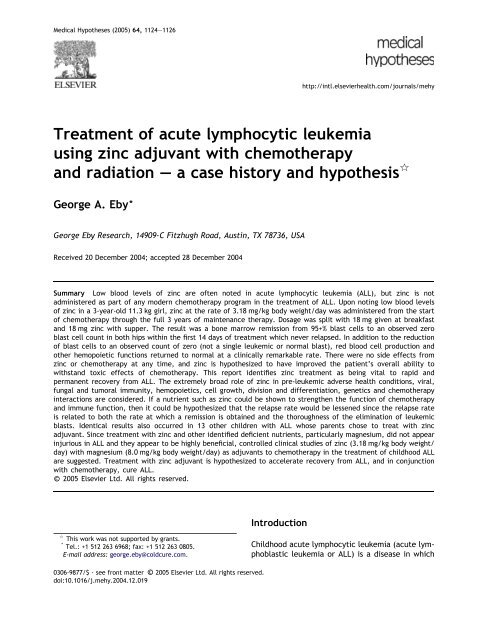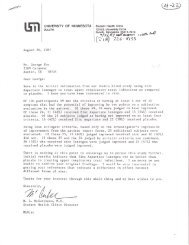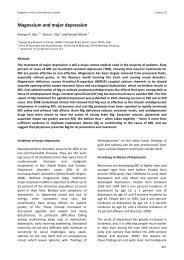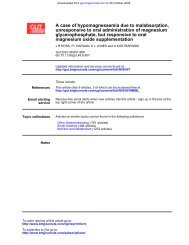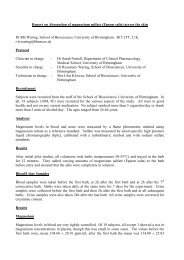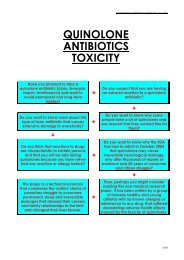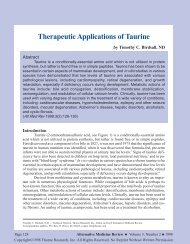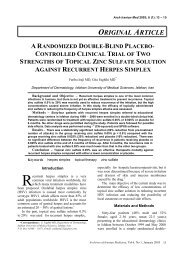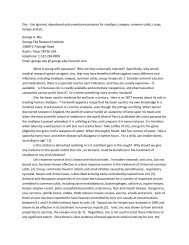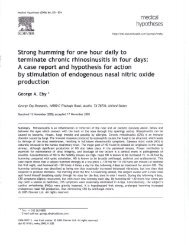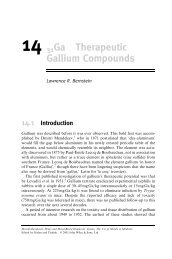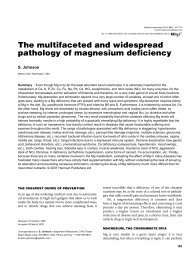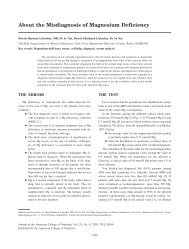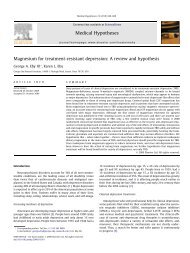Treatment of acute lymphocytic leukemia using zinc adjuvant with ...
Treatment of acute lymphocytic leukemia using zinc adjuvant with ...
Treatment of acute lymphocytic leukemia using zinc adjuvant with ...
You also want an ePaper? Increase the reach of your titles
YUMPU automatically turns print PDFs into web optimized ePapers that Google loves.
Medical Hypotheses (2005) 64, 1124–1126<br />
<strong>Treatment</strong> <strong>of</strong> <strong>acute</strong> <strong>lymphocytic</strong> <strong>leukemia</strong><br />
<strong>using</strong> <strong>zinc</strong> <strong>adjuvant</strong> <strong>with</strong> chemotherapy<br />
and radiation – a case history and hypothesis q<br />
George A. Eby *<br />
George Eby Research, 14909-C Fitzhugh Road, Austin, TX 78736, USA<br />
Received 20 December 2004; accepted 28 December 2004<br />
Summary Low blood levels <strong>of</strong> <strong>zinc</strong> are <strong>of</strong>ten noted in <strong>acute</strong> <strong>lymphocytic</strong> <strong>leukemia</strong> (ALL), but <strong>zinc</strong> is not<br />
administered as part <strong>of</strong> any modern chemotherapy program in the treatment <strong>of</strong> ALL. Upon noting low blood levels<br />
<strong>of</strong> <strong>zinc</strong> in a 3-year-old 11.3 kg girl, <strong>zinc</strong> at the rate <strong>of</strong> 3.18 mg/kg body weight/day was administered from the start<br />
<strong>of</strong> chemotherapy through the full 3 years <strong>of</strong> maintenance therapy. Dosage was split <strong>with</strong> 18 mg given at breakfast<br />
and 18 mg <strong>zinc</strong> <strong>with</strong> supper. The result was a bone marrow remission from 95+% blast cells to an observed zero<br />
blast cell count in both hips <strong>with</strong>in the first 14 days <strong>of</strong> treatment which never relapsed. In addition to the reduction<br />
<strong>of</strong> blast cells to an observed count <strong>of</strong> zero (not a single leukemic or normal blast), red blood cell production and<br />
other hemopoietic functions returned to normal at a clinically remarkable rate. There were no side effects from<br />
<strong>zinc</strong> or chemotherapy at any time, and <strong>zinc</strong> is hypothesized to have improved the patient’s overall ability to<br />
<strong>with</strong>stand toxic effects <strong>of</strong> chemotherapy. This report identifies <strong>zinc</strong> treatment as being vital to rapid and<br />
permanent recovery from ALL. The extremely broad role <strong>of</strong> <strong>zinc</strong> in pre-leukemic adverse health conditions, viral,<br />
fungal and tumoral immunity, hemopoietics, cell growth, division and differentiation, genetics and chemotherapy<br />
interactions are considered. If a nutrient such as <strong>zinc</strong> could be shown to strengthen the function <strong>of</strong> chemotherapy<br />
and immune function, then it could be hypothesized that the relapse rate would be lessened since the relapse rate<br />
is related to both the rate at which a remission is obtained and the thoroughness <strong>of</strong> the elimination <strong>of</strong> leukemic<br />
blasts. Identical results also occurred in 13 other children <strong>with</strong> ALL whose parents chose to treat <strong>with</strong> <strong>zinc</strong><br />
<strong>adjuvant</strong>. Since treatment <strong>with</strong> <strong>zinc</strong> and other identified deficient nutrients, particularly magnesium, did not appear<br />
injurious in ALL and they appear to be highly beneficial, controlled clinical studies <strong>of</strong> <strong>zinc</strong> (3.18 mg/kg body weight/<br />
day) <strong>with</strong> magnesium (8.0 mg/kg body weight/day) as <strong>adjuvant</strong>s to chemotherapy in the treatment <strong>of</strong> childhood ALL<br />
are suggested. <strong>Treatment</strong> <strong>with</strong> <strong>zinc</strong> <strong>adjuvant</strong> is hypothesized to accelerate recovery from ALL, and in conjunction<br />
<strong>with</strong> chemotherapy, cure ALL.<br />
c 2005 Elsevier Ltd. All rights reserved.<br />
q This work was not supported by grants.<br />
* Tel.: +1 512 263 6968; fax: +1 512 263 0805.<br />
E-mail address: george.eby@coldcure.com.<br />
0306-9877/$ - see front matter c 2005 Elsevier Ltd. All rights reserved.<br />
doi:10.1016/j.mehy.2004.12.019<br />
Introduction<br />
http://intl.elsevierhealth.com/journals/mehy<br />
Childhood <strong>acute</strong> <strong>lymphocytic</strong> <strong>leukemia</strong> (<strong>acute</strong> lymphoblastic<br />
<strong>leukemia</strong> or ALL) is a disease in which
<strong>Treatment</strong> <strong>of</strong> <strong>acute</strong> <strong>lymphocytic</strong> <strong>leukemia</strong> <strong>using</strong> <strong>zinc</strong> <strong>adjuvant</strong> 1125<br />
too many underdeveloped lymphocytes (infectionfighting<br />
white blood cells) develop in a child’s<br />
blood and bone marrow, ca<strong>using</strong> death if not controlled.<br />
Pre-<strong>acute</strong> <strong>lymphocytic</strong> <strong>leukemia</strong> in the<br />
child is <strong>of</strong>ten marked by: (a) severe atopic-like<br />
allergic reactions, (b) major and/or frequent upper<br />
respiratory viral infections and fevers, (c) taste and<br />
appetite suppression, (d) growth suppression, (e)<br />
lethargy and depression, (f) diarrhea, and (g)<br />
<strong>of</strong>fensive body odor (free asparagine). Each <strong>of</strong><br />
these conditions can be a symptom <strong>of</strong> <strong>zinc</strong><br />
deficiency.<br />
The cause <strong>of</strong> ALL is unknown. ALL is routinely<br />
treated <strong>with</strong> chemotherapy to kill leukemic cells,<br />
but little effort is exerted to improve overall<br />
health through dietary support, and no modern<br />
chemotherapy includes <strong>zinc</strong> <strong>adjuvant</strong> even though<br />
<strong>zinc</strong> serum levels are usually low in leukemic<br />
children.<br />
Leukemic cells contain much less <strong>zinc</strong> than normal<br />
lymphocytes, suggesting an error in <strong>zinc</strong><br />
metabolism, which appears correctable <strong>with</strong> <strong>zinc</strong><br />
treatment. Zinc is vital for recovery because<br />
<strong>zinc</strong> is required for proper functioning <strong>of</strong> genetics,<br />
immunity, formation <strong>of</strong> red blood cells, organ,<br />
muscle and bone function, cell membrane stability,<br />
cell growth, division, differentiation and genetics.<br />
Zinc has beneficial interactions <strong>with</strong> several chemotherapy<br />
drugs. Zinc metabolism deviations have<br />
been recognized in <strong>leukemia</strong> since 1949 but remain<br />
poorly understood, although <strong>zinc</strong> was used in the<br />
early 1950s as a <strong>leukemia</strong> therapy. These effects,<br />
interactions and relationships are reviewed at<br />
http://coldcure.com/html/<strong>leukemia</strong>.doc, and this<br />
web page and its html counterpart are archived at<br />
http://archive.org. Most remissions <strong>with</strong>out <strong>zinc</strong> in<br />
other children in 1979 after 30 days <strong>of</strong> treatment<br />
showed 3–5% blasts remaining in bone marrow.<br />
<strong>Treatment</strong> <strong>with</strong> <strong>zinc</strong> is hypothesized to accelerate<br />
recovery from ALL, and in conjunction <strong>with</strong> chemotherapy,<br />
cure ALL.<br />
Methods and procedures<br />
In a case <strong>of</strong> <strong>acute</strong> T-cell <strong>lymphocytic</strong> <strong>leukemia</strong><br />
(ALL) in a 3-year-old white female treated <strong>with</strong><br />
Children’s Cancer Study Group protocol 161, regimen<br />
2 (CCG 161), <strong>zinc</strong> (3.18 mg/kg body weight/<br />
day) as <strong>zinc</strong> gluconate was given as an <strong>adjuvant</strong><br />
to chemotherapy upon noting low serum <strong>zinc</strong>. The<br />
daily dosage (36 mg) was split into two 18 mg dosages<br />
and was given <strong>with</strong> morning and evening<br />
meals. Predisone, vincristine, L-asparaginase, and<br />
intrathecal methotrexate were used for remission<br />
induction followed by 2400 rads cranial radiation.<br />
Maintenance therapy was vincristine and predisone<br />
on a monthly ‘‘pulse’’ basis, methotrexate weekly<br />
and 6-mercaptopurine daily. <strong>Treatment</strong> occurred<br />
1979 through 1982, at Santa Rosa Hospital in San<br />
Antonio, Texas.<br />
The decision to supplement <strong>zinc</strong> and all nutrients<br />
(except folic acid and calcium) <strong>using</strong> adult<br />
RDA doses was made by a parent (this writer),<br />
not the oncologist or hospital, but <strong>with</strong> their<br />
knowledge and permission. Nutrient treatment<br />
was only to preclude nutrient deficiencies brought<br />
on by chemotherapy and poor eating habits. Zinc<br />
was continued for the 3 years <strong>of</strong> chemotherapy at<br />
the rate <strong>of</strong> 3.18 mg/kg body weight/day.<br />
Results<br />
A bone marrow remission from 95+% blast cells to<br />
an observed zero blast cell count in both hips occurred<br />
<strong>with</strong>in 14 days <strong>of</strong> simultaneous initiation<br />
<strong>of</strong> chemotherapy and nutrients. Not a single leukemic<br />
cell or immature lymphocyte was observed. In<br />
addition to the reduction <strong>of</strong> blast cells to zero, red<br />
blood cell production and other hemopoietic functions<br />
returned to normal at a clinically remarkable<br />
rate. During the 3 years <strong>of</strong> maintenance therapy, a<br />
continuous remission (0.2–1.5% bone marrow<br />
blasts) was maintained. When chemotherapy was<br />
temporarily suspended at year 2 in order to administer<br />
chicken-pox vaccine, bone marrow blast<br />
count only rose to 2%, and then returned to 0.2%<br />
after resumption <strong>of</strong> chemotherapy.<br />
Total white blood cell count averaged 4000/<br />
mm 3 and infrequently varied between 2000/mm 3<br />
and 7000/mm 3 . Absolute lymphocyte count remained<br />
1000/mm 3 or less. Moon-face appearance<br />
and obesity normally found <strong>with</strong> use <strong>of</strong> predisone<br />
were absent. Immunity to disease was normal,<br />
and she was not immunosuppressed. Incidence <strong>of</strong><br />
infection was much lower after initiation <strong>of</strong> chemotherapy<br />
<strong>with</strong> <strong>zinc</strong> than during an equivalent period<br />
prior to diagnosis. Activated lymphocytes were<br />
noted in 12% <strong>of</strong> the bi-weekly blood tests. A<br />
‘‘catch-up’’ growth occurred from pre-<strong>leukemia</strong><br />
height and weight <strong>of</strong> 28% and 5%, respectively, to<br />
50% and 50%, respectively, after 1 year <strong>of</strong> treatment.<br />
Growth remained at the 50% level for both<br />
height and weight during the 3-year chemotherapy<br />
treatment. In general, the child enjoyed excellent<br />
health.<br />
Oral <strong>zinc</strong> treatment (3.18 mg/kg body weight/<br />
day) was continued throughout the 3-year chemotherapy<br />
program. Zinc serum level remained in
1126 Eby<br />
the 130–140 mcg/dl range (high end <strong>of</strong> normal). All<br />
vitamins except folic acid, all minerals (except<br />
calcium) and all known trace minerals were given<br />
daily in adult dosages. All serum nutrient levels<br />
remained in the normal range.<br />
After 2 years <strong>of</strong> treatment, she beneficially<br />
developed a titer <strong>of</strong> 1024 to chicken pox virus<br />
and demonstrated strong CMI response to chicken<br />
pox in vitro after inoculation <strong>with</strong> the Japanese<br />
vaccine to chicken pox.<br />
No adverse effects from chemotherapy or nutrient<br />
treatment were observed at any time. Her<br />
blood count returned to normal <strong>with</strong>in 3 months<br />
<strong>of</strong> cessation <strong>of</strong> chemotherapy. She never relapsed<br />
and is currently a neuropsychology graduate<br />
student.<br />
Discussion<br />
Zinc and other nutrient administration was not<br />
harmful in any way. Since bone marrow improvements<br />
normally obtained <strong>using</strong> chemotherapy contain<br />
3–5% blasts after 30 days <strong>of</strong> chemotherapy,<br />
these results (zero blasts) were a significant<br />
improvement. Since the rate in which a remission<br />
is obtained – as well as the reduction in blast count<br />
– is related to the propensity to relapse, these<br />
observations are also important and suggest that<br />
<strong>zinc</strong> should be administered to children <strong>with</strong> ALL<br />
as part <strong>of</strong> formal protocols.<br />
Zinc lozenges that release ionic <strong>zinc</strong> can shorten<br />
common colds by 7 days [1], probably by cell membrane<br />
stabilization [2]. These lozenges were effective<br />
in greatly shortening her colds during the<br />
3-year maintenance program. On the other hand,<br />
<strong>zinc</strong> dietary supplements and lozenges <strong>with</strong>out ionic<br />
<strong>zinc</strong> (the prevalent OTC form in the US due to<br />
flavor issues) do not significantly shorten colds.<br />
Additionally, there is a high prevalence <strong>of</strong> both<br />
<strong>zinc</strong> and intracellular magnesium (ionic magnesium)<br />
deficiency in T-cell lymphoblastic <strong>leukemia</strong><br />
[3]. Intracellular magnesium deficiency causes the<br />
osteoporosis found in ALL [6]. Although serum magnesium<br />
is low only in alcoholism, intracellular magnesium<br />
deficiency is widespread, affecting over<br />
70% <strong>of</strong> the public [4,5] due to reliance upon nutri-<br />
ent-depleted refined grain products and sugar for<br />
calories. Over 99% <strong>of</strong> all magnesium is intracellular,<br />
and serum tests are totally misleading. That<br />
either <strong>zinc</strong> or intracellular ionic magnesium deficiency<br />
can cause genetic and cellular replication<br />
perturbations is well known, and that this combination<br />
<strong>of</strong> deficiencies is a necessary precondition for<br />
development <strong>of</strong> ALL is hypothesized.<br />
In clinical practice, there is a well known correlation<br />
between return <strong>of</strong> <strong>zinc</strong> serum levels to<br />
normal and survival in ALL. However, no modern<br />
<strong>leukemia</strong> therapy, <strong>with</strong> the exception <strong>of</strong> the Polish<br />
trial [7], used <strong>zinc</strong> treatment. Thirteen other<br />
parents supplemented their leukemic child <strong>with</strong><br />
<strong>zinc</strong> due to a newspaper account <strong>of</strong> this 1979<br />
incident, <strong>with</strong> all having the same beneficial<br />
results.<br />
Since treatment <strong>with</strong> <strong>zinc</strong> and other nutrients<br />
(except folic acid) does not appear injurious in<br />
ALL and appears to be highly beneficial, controlled<br />
clinical studies <strong>of</strong> <strong>zinc</strong> (3.18 mg/kg body<br />
weight/day) <strong>with</strong> magnesium (8.0 mg/kg body<br />
weight/day) used as an <strong>adjuvant</strong> to chemotherapy<br />
in the treatment <strong>of</strong> childhood ALL are<br />
needed.<br />
References<br />
[1] Eby GA. Zinc lozenges: cold cure or candy? Solution<br />
chemistry determinants. Biosci Rep 2004;24:23–39.<br />
[2] Bashford CL, Rodriques L, Pasternak CA. Protection <strong>of</strong> cells<br />
against membrane damage by haemolytic agents: divalent<br />
cations and protons act at the extracellular side <strong>of</strong> the<br />
plasma membrane. Biochim Biophys Acta 1989;983(1):<br />
56–64.<br />
[3] Sahin G, Ertem U, Duru F, Birgen D, Yuksek N. High<br />
prevelance <strong>of</strong> chronic magnesium deficiency in T cell<br />
lymphoblastic <strong>leukemia</strong> and chronic <strong>zinc</strong> deficiency in<br />
children <strong>with</strong> <strong>acute</strong> lymphoblastic <strong>leukemia</strong> and malignant<br />
lymphoma. Leuk Lymphoma 2000;39:555–62.<br />
[4] Seelig MS, Rosan<strong>of</strong>f AR. The magnesium factor. New<br />
York: Avery Press; 2003.<br />
[5] Dean C. The miracle <strong>of</strong> magnesium. New York: Ballantine;<br />
2003.<br />
[6] Manson D, Martin RF, Cockshott WP. Metaphyseal impaction<br />
fractures in <strong>acute</strong> lymphoblastic <strong>leukemia</strong>. Skeletal Radiol<br />
1989;17:561–4.<br />
[7] Czyzewska MW. Immunostimulatory effect <strong>of</strong> <strong>zinc</strong> in<br />
patients <strong>with</strong> <strong>acute</strong> lymphoblastic <strong>leukemia</strong>. Folia Haematol,<br />
Leipzig 1978;105:727–32.


